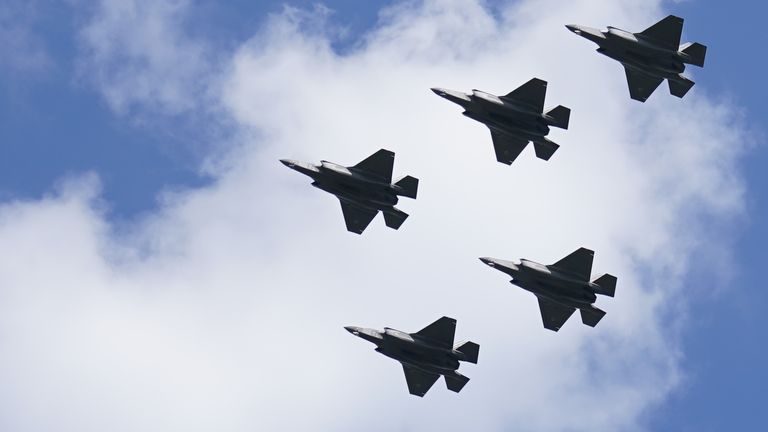Coronation robes revealed along with changes to languages and faiths involved in ceremony | UK News
A lavish new Robe of Estate, decorated with bees, a beetle and flowers, has been made for the Queen Consort to wear after her coronation.
Only small glimpses have been released, ensuring the whole ensemble remains under wraps until the big day.
Announcements have also been made about traditional languages forming part of the coronation service, and multi-faith elements, too.
A Robe of Estate is a long velvet garment worn by a British monarch after their coronation.
Camilla’s is embroidered in goldwork threads, drawing on themes of nature and the environment.
It has been hand embroidered by the Royal School of Needlework, of which the Queen Consort is patron.
Incorporating delphiniums, it pays tribute to one of the King’s favourite flowers. It is also Camilla’s birth month flower.
It references the late Queen, too, by including her favourite bloom, the lily of the valley.
Camilla will wear the grand garment, which also includes her cypher, for her departure from Westminster Abbey.
King Charles will wear his grandfather George VI’s Robes of State and Estate from the coronation in 1937, which are almost 90 years old.
They have been conserved and prepared for the occasion.
A Robe of State is worn by a British monarch on state occasions, such as during the State Opening of Parliament.
Robes of State are crimson while Robes of Estate are purple.
Camilla’s Robe of State, to be worn on her arrival at Westminster Abbey, is the one made for the Queen’s coronation in 1953.
It has been conserved – with adjustments – and has a 5.5 metre train.
A Buckingham Palace spokesperson said: “For the first time, insects including bees and a beetle feature on the Coronation Robe, drawing on the themes of nature and the environment and reflecting their Majesties’ affection for the natural world.”
There are also national emblems – the rose, thistle and shamrock.
Read more from Sky News:
Stone of Destiny arrives in London for King’s coronation
The weird and wonderful products used to mark the crowning of Charles
Changes to languages and faiths involved
Organisers have also announced changes to the languages being used at the coronation ceremony, as well as the faiths involved.
The coronation congregation will hear three Celtic languages – Welsh, Scottish Gaelic and Irish Gaelic – alongside English.
As a young man, the King travelled to Aberystwyth University to learn the Welsh language from Welsh nationalist Dr Edward Millward.
That was prior to his investiture as the Prince of Wales at Caernarfon Castle in 1969.
There will also be a multi-faith element, visible from the opening moments, with representatives taking part in a series of processions into Westminster Abbey that will culminate with the entrance of the King and Queen Consort.
Among them will be leaders and others from the Jewish, Sunni and Shia Muslim, Sikh, Buddhist, Hindu, Jain, Bahai and Zoroastrian communities.
When the regalia is presented to the King, Sikh, Hindu, Muslim and Jewish peers will take part, handing over items which do not have Christian meaning or symbolism.
The following religious leaders will take part in a greeting to the King at the end of the coronation service:
• Chief Rabbi Sir Ephraim Mirvis, KBE (Judaism)
• The Most Venerable Bogoda Seelawimala (Buddhism)
• The Rt. Hon. The Lord Singh of Wimbledon, CBE (Sikhism)
• Radha Mohan das (Hinduism)
• Aliya Azam, MBE (Islam)
The leaders will tell the newly crowned King: “Your Majesty, as neighbours in faith, we acknowledge the value of public service.
“We unite with people of all faiths and beliefs in thanksgiving, and in service with you for the common good.”
The King will acknowledge the greeting.


